


 |
 |

|
| Trip Planning | History of Greece | Overview of Kalamata | Itinerary | Photos |
|
Trip Planning |
Virginia and Chuck on the Queen Mary II on their Transatlantic cruise from South Hampton to New York City.
We thought we might go to Kalamata and Athens for a quick trip after the COVID-19 pandemic!
Board the Viking Sea on August 20th, 2021 and tour Malta - Cruise to Kalamata for a day and then on to Athens for two days, both on the main land of Greece.
Then cruise to the islands of Santorini and on to Rhodes and finally Crete. Then back to Malta.
I already have been to Sicily and Sardinia on a previous cruise with Virginia in 2018 for my 78th birthday!
|
Brief History of Greece and a Map |
Statistics of Greece
Location: Southern Europe, bordering the Aegean Sea, Ionian Sea, and the Mediterranean Sea, between Albania and Turkey.
Read more about the history of Greece.......
|
Brief Overview of Kalamata |
The modern name Kalamata is a corruption of the older name for "reeds". The phonetic similarity of Kalamata with the phrase ("good eyes") has led to various folk etymologies.
Kalamata is the second most populous city of the Peloponnese peninsula, after Patras, in southern Greece and the largest city of the homonymous administrative region. As the capital and chief port of the Messenia regional unit, it lies along the Nedon River at the head of the Messenian Gulf.
The 2011 census recorded 69,849 inhabitants for the wider Kalamata Municipality, of which, 62,409 resided in the municipal unit of Kalamata, and 54,567 in the city proper.
Kalamata is renowned as the land of the Kalamatianos dance and Kalamata olives.
After visiting Kalamata and Athens we will continue on the cruise to Santorini, Rhodes and Crete, then back to Malta and our flight back to San Francisco.
|
Palace of Nestor |
Overview
The Palace of Nestor (Katharevousa) was an important centre in Mycenaean times, and described in Homer's Odyssey and Iliad as Nestor's kingdom of "sandy Pylos".

The palace featured in the story of the Trojan War, as Homer tells us that:
- Telemachus went to Pylos and to Nestor, the shepherd of the people, and he received me in his lofty house and gave me kindly welcome, as a father might his own son who after a long time had newly come from afar: even so kindly he tended me with his glorious sons.
The site is the best preserved Mycenaean Greek palace discovered. The palace is the primary structure within a larger Late Helladic era settlement, once probably surrounded by a fortified wall. The palace was a two-storey building with store rooms, workshops, baths, light wells, reception rooms and a sewage system. The settlement had been long occupied with most artifacts discovered dating from 1300 BC. The palace complex was destroyed by fire around 1200 BC.
In June 2016 the site re-opened to the public after the roof was replaced by a modern structure with raised walkways for visitors.
Excavations
In 1912 and 1926 two tholos tombs north of the Bay of Navarino were excavated. One contained three decorated jars and the other a collection of Early Mycenaean and Middle Helladic pots.
A joint Hellenic-American expedition was formed with the Greek Archaeological Service and the University of Cincinnati and trial excavations of Epano Englianos were started on 4 April 1939. From the first day stone walls, fresco fragments, Mycenaean pottery and inscribed tablets were found.
During excavation in 1939 around 1,000 Linear B tablets were found. A systematic excavation was impossible throughout World War II and excavations resumed in 1952. From 1952 to 1966 the Palace was uncovered with areas around the acropolis being further explored. A breakthrough in translating the Linear B tablets was achieved by Michael Ventris, an English architect in 1952 who found that it was an archaic form of Greek. The translation of such tablets in the following years showed that they consisted of part of the royal archive.
The Griffin Warrior Tomb
In 2015 the University of Cincinnati uncovered an extraordinarily rich find not far from the palace. This undisturbed burial of a Mycenaean warrior, called the "griffin warrior" by the team, yielded gold rings, bronze weapons, and many other artifacts. The iconography of the artifacts displays a mixture of Minoan and Mycenaean culture.
|
Itinerary - Day 4 |
Palace of Nestor
Explore the Palace of Nestor, one of the best-preserved structures of the Mycenaean civilization. The Mycenaeans ruled over the Ancient Greek mainland during the Late Bronze Age, before collapsing for unknown reasons sometime during the 12th century BC. Situated on a nearby hilltop above Navarino Bay, visit the remains of the palace of Nestor at Pylos. Built during the 13th century BC by the fabled king of the Homeric epics, the palace was almost completely destroyed by fire a century later. Extensive excavations viewed from an elevated platform provide insights to its former grandeur; see the sprawling floorplan, including the throne room with its circular clay heath, discover various workshops and the wine cellar, and view the frescoes that adorn the palace walls. Admire the sweeping views of the bay and surrounding countryside before returning to your ship.
|
Photos |

Ports of Calls on the Cruise. |

Cruise Ship - Viking Sea |

Millions of Olive Trees! |

Entrance to the Palace. |

Working on the Bath Room digs! |

Actual Bath Tub and a step to get into it! |

More rooms. |

Throne Room - Ceiling open to the sky - Fire buring in the center! |

Storage pots in the ground for Olive Oil. |

Work Shop area. |

Entrance to the burial chamber. |

Huge Domed Ceiling! |

How the stones were stacked! |

White Ladies in the Explorer Bar! |
 |
 |

|
| Trip Planning | Athens History | Itinerary | Photos |
|
Trip Planning |

Chuck in Athens in 1992 on the way to Egypt. I got a photograph of me in front of the Acropolis even thought there were hundreds of Greeks visiting with their families as it was a Sunday! I flew on the Greek Olympic Airlines, one of the worst experiences I ever had on a flight. Engine problems in New York, 24 hour delay, ended up in Manhattan for ten hours. Then a smoke filled cabin for 10 hours, backup toilets and so on. Day late in Athens, lay over for ten hours so we took a cab and toured Athens. Of to Cairo but the new jet plane had windows with rubber seals hanging in between the window panes! We finally made Cario but lost a day tour of the city, we did see the pyramid light show the first night, then off to fly to Thebes and take a boat ride to Aswan and on to Able Simble near the Sudan border!
Virginia and Chuck in 2019, on the Queen Mary II on their Transatlantic cruise from South Hampton to New York City. We thought we might go to Athens and the Greek Islands for a quick trip after the COVID-19 pandemic!
Board the Viking Sea on August 20th, 2021 - Cruise from the island of Malta to Kalamata and then on to Athens, both on the main land of Greece. Then cruise to the islands of Santorini and on to Rhodes and finally Crete. Then back to Malta.
I already have been to Sicily and Sardinia on a previous cruise with Virginia in 2018 for my 78th birthday!
|
Brief Overview of Athens |
Athens is one of the oldest named cities in the world, having been continuously inhabited for perhaps 5,000 years. Situated in southern Europe, Athens became the leading city of Ancient Greece in the first millennium BC, and its cultural achievements during the 5th century BC laid the foundations of Western civilization.During the early Middle Ages, the city experienced a decline, then recovered under the later Byzantine Empire and was relatively prosperous during the period of the Crusades (12th and 13th centuries), benefiting from Italian trade. Following a period of sharp decline under the rule of the Ottoman Empire, Athens re-emerged in the 19th century as the capital of the independent and self-governing Greek state.
The name of Athens, connected to the name of its patron goddess Athena, originates from an earlier Pre-Greek language. The origin myth explaining how Athens acquired this name through the legendary contest between Poseidon and Athena was described by Herodotus, Apollodorus, Ovid, Plutarch, Pausanias and others. It even became the theme of the sculpture on the West pediment of the Parthenon. Both Athena and Poseidon requested to be patrons of the city and to give their name to it, so they competed with offering the city one gift each. Poseidon produced a spring by striking the ground with his trident, symbolizing naval power. The contest of Athena and Poseidon, West Pediment of the Parthenon Athena created the olive tree, symbolizing peace and prosperity. The Athenians, under their ruler Cecrops, accepted the olive tree and named the city after Athena. (Later the Southern Italian city of Paestum was founded under the name of Poseidonia at about 600 BC.) A sacred olive tree said to be the one created by the goddess was still kept on the Acropolis at the time of Pausanias (2nd century AD). It was located by the temple of Pandrosus, next to the Parthenon. According to Herodotus, the tree had been burnt down during the Persian Wars, but a shoot sprung from the stump. The Greeks saw this as a symbol that Athena still had her mark there on the city. Plato, in his dialogue Cratylus, offers his own etymology of Athena's name connecting it to the phrase ('the mind of god').
|
Itinerary - Day 5 |
Panoramic Athens & Archaeology - Day 5
See the highlights of Athens by motor coach and visit the National Archaeological Museum. From the port of Piraeus, journey with your guide into ancient Athens. You will pass the small harbor of Zea, whose 5th-century BC dock still survives, and the elegant promenade at Mikrolimano. In the center of historic Athens, you will see the Hellenic Parliament and Syntagma (Constitution) Square, as well as the distinctively uniformed Presidential Guard, or "Evzones," at the Tomb of the Unknown Soldier. Your scenic drive also includes views of Panathenaic Stadium and the Temple of Olympian Zeus. Following the panoramic tour, you will visit the National Archaeological Museum, one of the world's great museums. With more than 11,000 exhibits, it provides a panorama of Greek civilization from the beginnings of prehistory to Late Antiquity.
|
Photos - Day 5 |

Ports of Calls on the Cruise |

Cruise Ship - Viking Sea |

Local stores. |

Ambassadores Lodgings. |

Goverment Offices. |

National Archaeological Museum |

|

|

|

|
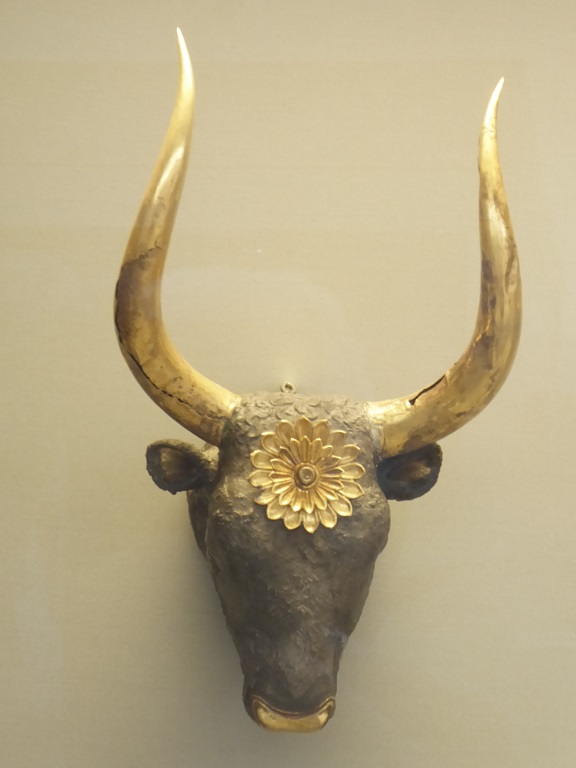
Creatian Bull. |

600 BCE roughly carved statues. |

Brother and Sister. |

Carvings are becomming more life like. |
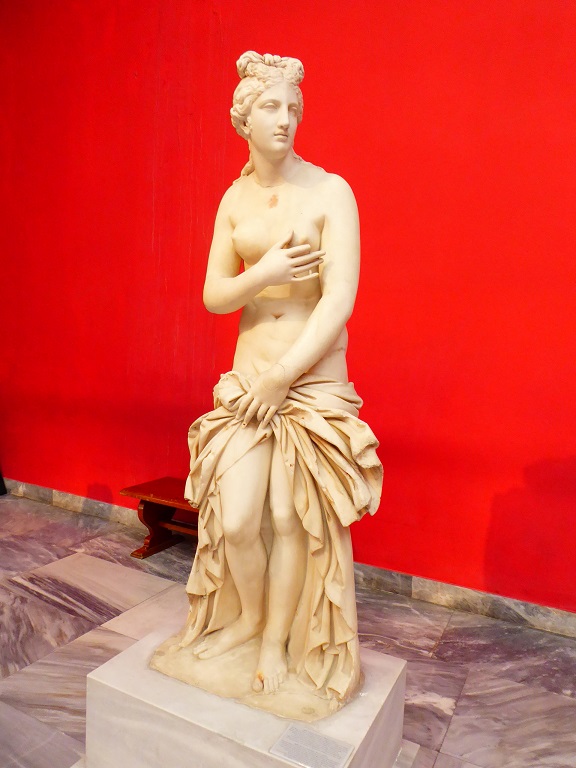
Roman Carvings. |
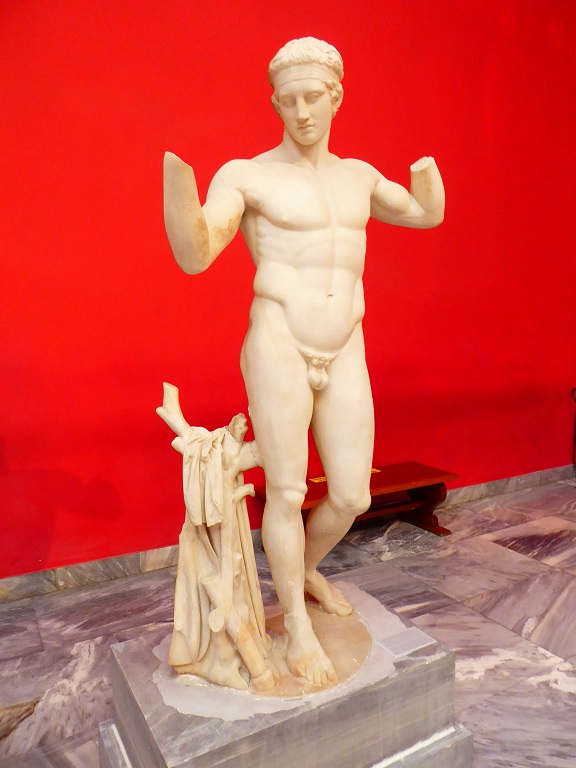
The cloth details are not defined as they should be. |

Fanastic Bronze of Zeus! |
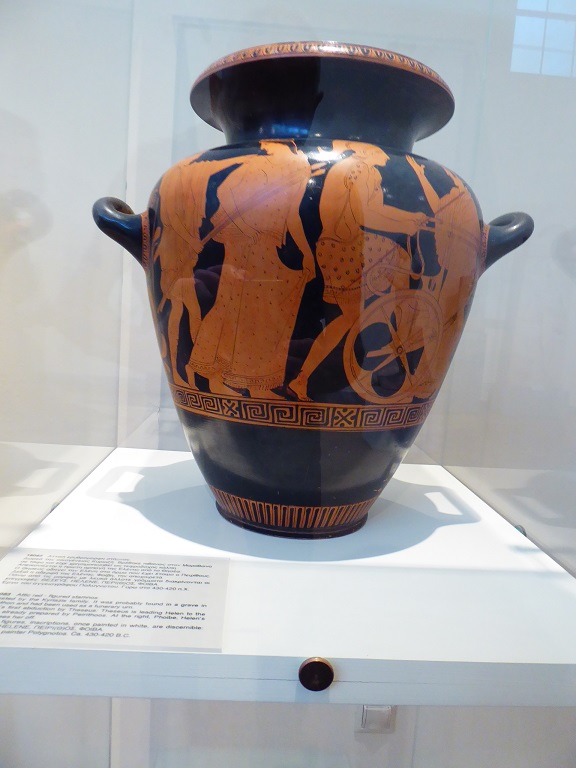
Greek Pottery - The best from anyplace! |
|
Itinerary - Day 6 |
Ancient Corinth & Canal - Day 6Early morning motor coach ride for a short drive to the famous Corinth Canal; plans to build a canal through the Isthmus of Corinth predate the Romans, but the 4-mile long waterway carved through steep limestone was not completed until the late 19th century.
Then discover one of the most powerful cities of antiquity during a visit to ancient Corinth. Vestiges of its importance can be seen in the many archaeological sites that dot the old city. Join your knowledgeable guide on a walking tour to see iconic landmarks such as the monolithic Doric columns of the Temple of Apollo, the 15,000-capacity ancient theater and the imposing Acrocorinth, a hilltop fortress that had protected the city from antiquity to the 19th century.
Corinth Canal:
The Corinth Canal connects the Gulf of Corinth in the Ionian Sea with the Saronic Gulf in the Aegean Sea. It cuts through the narrow Isthmus of Corinth and separates the Peloponnese from the Greek mainland, arguably making the peninsula an island.
The canal was dug through the isthmus at sea level and has no locks. It is 6.4 kilometres (4 mi) in length and only 21.4 metres (70 ft) wide at its base, making it impassable for many modern ships. It has little economic importance and is mainly a tourist attraction.
The canal was initially proposed in classical times and a failed effort was made to build it in the 1st century AD. Construction recommenced in 1881 but was hampered by geological and financial problems that bankrupted the original builders.
It was completed in 1893, but, due to the canal's narrowness, navigational problems, and periodic closures to repair landslides from its steep walls, it failed to attract the level of traffic expected by its operators.

Corinth Canal - 1881 - 1893 |

Nero of all people, first draw the route for the Canal! |

It is about four miles long. |

Too small for large ships to traverse! |
Temples to Aphrodite and Apollo: As men talk in a dream, so Corinth all, wrote the poet Keats of this ancient city, with its still-surviving temples to Aphrodite and Apollo.
The ancient city of Corinth is located on a narrow stretch of land joining the mainland of Greece and the Peloponnese. Before being sacked by the Romans in 146 BC, the city was one of Greece's major establishments, flourishing with commerce resulting from its tactical location. Under the Romans, the city continued to prosper, which explains why the most interesting ruins to view here are of Roman build. When visiting, check out the Temple of Aphrodite, the Temple of Apollo and the Roman forum. There is also a sacred spring with a secret passage nearby, leading to a small shrine.
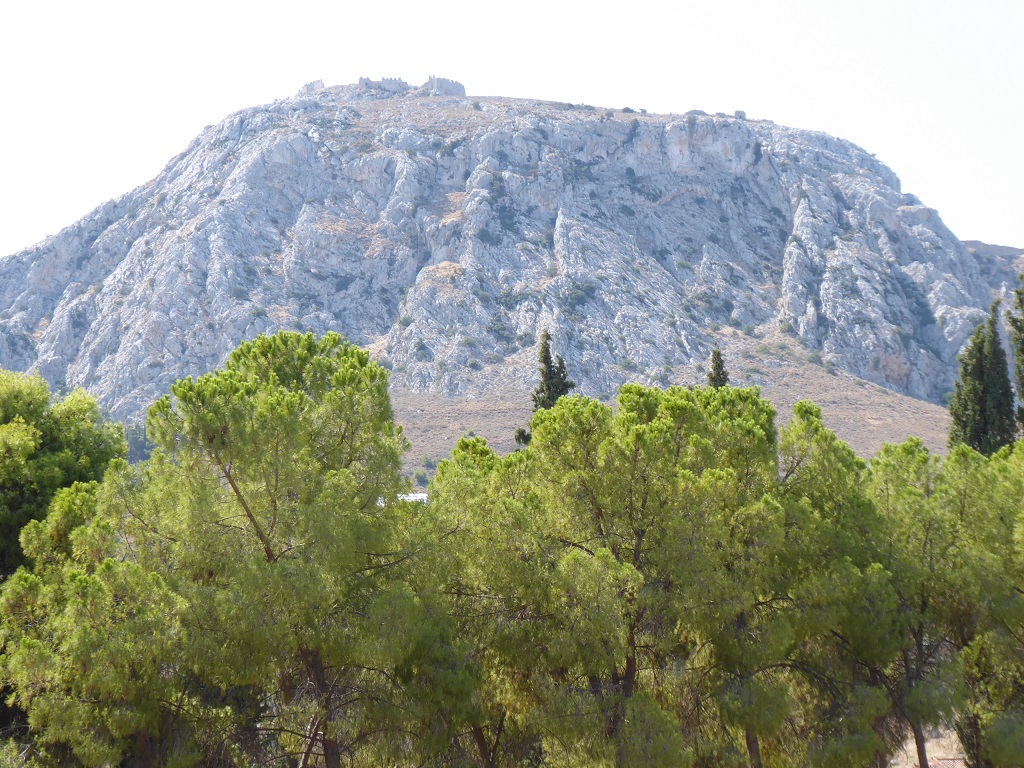
Limestone Mountains - No Water!
See a fort on the top! Imagine getting food and water up there! |
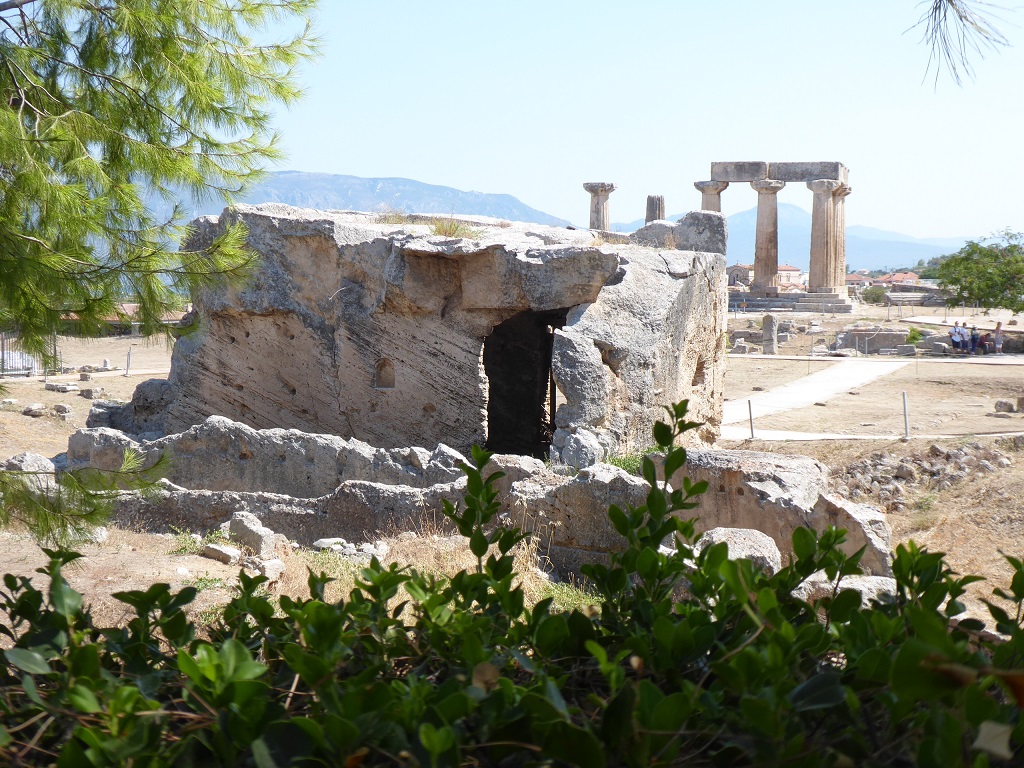
Temple of Aphrodite |

|

|

|

|

Original Roman Road! |

Monastery in the distance. |
| Created on: 2021.06.04 |
|
 |
|
Updated on: 2021.09.07 |